The effective mass of a tonearm is not actually mass at all, but inertia, and inertia is obtained by multiplying the mass of a component by the square of the distance between the centre of mass of the component and the pivot - headshell, armtube, and CBW are the major/significant components of all toenarms (the yolk/bearing assembly is generally reasonably symetrical about the pivot, so has essentially no distance between centre of its mass and pivot and the CBW stub-shaft is generally (very) small with a CoG close to the pivot).
Beacuse the centre of mass (also called centre of gravity) of the headshell is so far from the pivot, the contibution of its inertia to the total inertia (effective mass) of the tonearm, is disproportionately large due to that distance being squared in the calculation.
Headshell mass is very important/has a major influence on your tonearm.
NOTE - due to similar logic, using a heavier CBW reduces effective mass/inertia of the tonearm. Taking an extreme and unrealistic example - double the mass and you will halve the distance pivot to CoG, so one quater of the contribution due to distance, mutiplied by doube the mass.
Inertia is a measure of how resistant a body is to being disturbed either from rest or continuing in its steady motion - a measure of "stability", if you like.


